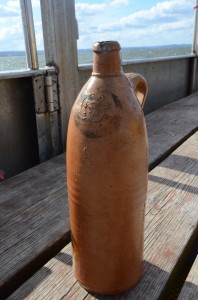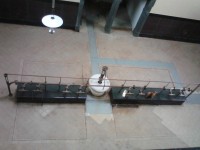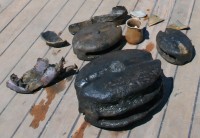 An intact sealed mineral water bottle from the German town of Selters has been retrieved from a shipwreck in the Baltic Sea off the coast of Poland. There’s a maker’s seal on the front of the bottle, a faded dark brown circle around the circular text “Selters” with the initial H and N topped by a crown inside, which identify it has having been manufactured between 1806 and 1830. The stoneware bottle still has liquid inside which is not seawater, but it’s possible the bottle was reused and recorked so archaeologists won’t know if there’s prized 200-year-old mineral water in there until they test the contents in a lab.
An intact sealed mineral water bottle from the German town of Selters has been retrieved from a shipwreck in the Baltic Sea off the coast of Poland. There’s a maker’s seal on the front of the bottle, a faded dark brown circle around the circular text “Selters” with the initial H and N topped by a crown inside, which identify it has having been manufactured between 1806 and 1830. The stoneware bottle still has liquid inside which is not seawater, but it’s possible the bottle was reused and recorked so archaeologists won’t know if there’s prized 200-year-old mineral water in there until they test the contents in a lab.
The H and N on the seal stand for Herzogthum Nassau, meaning Duchy of Nassau, a province in western Germany that is today the state of Hesse. The Selters area of the province on northern slopes of the Taunus mountains was famous for its mineral springs. Long before the duchy existed when the region was part of the Electorate of Trier ruled by a prince-archbishop, local monasteries documented the wells in records from the 8th century. By the 16th century Selters’ naturally carbonated water was well known all over the country. German doctors wrote papers on its curative properties and the crisp, pleasantly sour taste from its uniquely high alkaline salt content.
Starting in the mid-18th century, the water was packaged in stoneware vessels and sold internationally. Shipments went out to the Netherlands, Sweden, England, France, Russia, Africa, even as far afield as America and Jakarta. It was a highly profitable venture, with more than a million jugs sold in 1791. The Electorate west of the Rhine was occupied by France in 1803 and absorbed into the French diocesan system. East of the Rhine its territories were secularized and incorporated into the county of Nassau-Weilburg which merged with Nassau-Usingen to form the Duchy of Nassau in 1806.
 The Duchy would only last for 60 years (it was annexed by Prussia in 1866), but during its existence the Selters water was its primary export. In 1850 three million jugs were sold, bringing in annual net profits of 100,000 guilders to the Duke’s privy purse. A public fountain allowed locals to collect the prized water free for home use.
The Duchy would only last for 60 years (it was annexed by Prussia in 1866), but during its existence the Selters water was its primary export. In 1850 three million jugs were sold, bringing in annual net profits of 100,000 guilders to the Duke’s privy purse. A public fountain allowed locals to collect the prized water free for home use.
The stoneware bottles were quite ingeniously designed to preserve the freshness and carbonation of the water. The necks were kept short and the bottles filled all the way to the top before being corked and cemented. The aim was to keep air out in order to preserve the fizz and flavor. As long as the air bubble in the neck was small (or non-existent, ideally) and the cork held, the water would retain its unique qualities in the sealed bottle for months. In the mid-19th century, analytical chemist Dr. Remigius Fresenius of the Wiesbaden Agricultural Institution stored Selters water for 15 years and found it substantially unchanged when he retested it.
Selters water was so famous worldwide that when artificial carbonation was invented, some of its products were referred to as “Selterser water,” aka water of Selters, aka seltzer water. Thus Selters became a genericized trademark, like Xerox for photocopies or Kleenex for tissues.
With millions sold every year for more than a century, many Selters stoneware bottles have survived. Corked and sealed ones, however are much more rare. The one discovered on the shipwreck is by far the most valuable object recovered from the unidentified vessel, labeled simply F-33-31, which lies 40 feet deep in Gdańsk Bay. In addition to its inherent coolness, the bottle has helped narrow down the ship’s age. Dendrochronological analysis of wood samples from the ships planks should narrow it down further.
 The underwater archaeologists from the National Maritime Museum in Gdańsk surveying the wreck have also found pottery fragments, small metal and ceramic vessels, shoe parts and ship parts, including wooden pulley blocks. They’ve also found a number of large stones which they believe were the ship’s main cargo, used in the construction of foundations or fortifications.
The underwater archaeologists from the National Maritime Museum in Gdańsk surveying the wreck have also found pottery fragments, small metal and ceramic vessels, shoe parts and ship parts, including wooden pulley blocks. They’ve also found a number of large stones which they believe were the ship’s main cargo, used in the construction of foundations or fortifications.
Once the survey is complete, the data and images will be used to create a 3D digital model of the wreck. The team has taken more than 7,000 pictures of the site from which a highly detailed virtual model can be constructed, an innovative approach to underwater archaeology that the National Maritime Museum has pioneered. After testing, the water bottle will go on display at the National Maritime Museum.